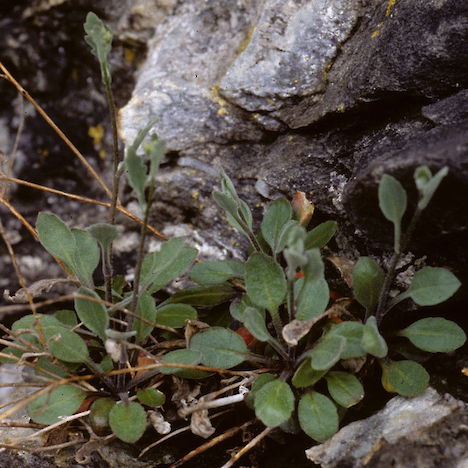Other names:
Ischnocarpus novae-zelandiaeThreat category:
Threatened: Nationally Endangered?Regions:
Marlborough, Canterbury, Otago, SouthlandDistribution:
Eastern South Island
Key Features
- Perennial herb with a deep taproot and woody base. Narrow to spoon-shaped, lobed, hairy leaves are borne in a basal rosette and are up to 10 cm long, but usually shorter. Flowering stems are up to 40 cm tall, with smaller leaves and a slender, terminal inflorescence with small white narrow petsals that ripens into a small cluster of slim pods.
Distribution and Habitat
- Eastern South Island, lowland to montane in open sites associated with dry cliffs, tussock and scrub.
- This species was previously known as Ischnocarpus novae-zelandiae.
Threats
- Habitat modification and loss.
- Browse by stock and insects.
- Fungal disease.
- Damage from recreational activities (e.g. rock climbing).
Management Opportunities
- Survey for new locations.
- Mark known sites.
- Protection of habitat.
- Control browsing animals.
Monitoring Options
- Check existing populations annually.
- Report new locations to DOC, NZPCN.
Further Information and Support
- New Zealand Plant Conservation Network (NZPCN). http://www.nzpcn.org.nz
- References:
- Dopson, S.R.; de Lange, P.J.; Ogle, C.C.; Rance, B.D.; Courtney, S. & Molloy, J. (1999). The conservation requirements of New Zealand’s nationally threatened vascular plants. Threatened Species Occasional Publication 13. Department of Conservation, Wellington.
- Peter de Lange, Peter Heenan, David Norton, Jeremy Rolfe and John Sawyer (2010). Threatened Plants of New Zealand. Canterbury University Press, Christchurch. 472 pp.
- Heenan P.B., Mitchell A.D., and Koch M. (2002). Molecular systematics of the New Zealand Pachycladon (Brassicaceae) complex: generic circumscription and relationships to Arabidopsis s. l. and Arabis s. l. New Zealand Journal of Botany 40: 543–562.




